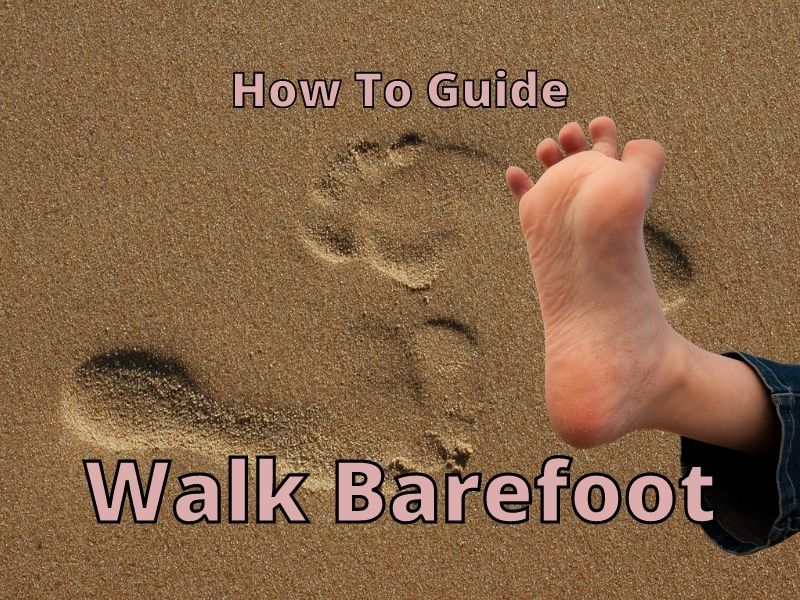When I was a kid I would walk barefoot much more often than I do as an adult. I walked in the house and outside without worrying about putting on shoes. The environment was fairly safe: grass, dirt, asphalt, and cement.
You can walk barefoot by making sure your feet are conditioned over time in fairly safe environments to develop a thicker skin and stronger foot muscles. Then you can adapt to more rugged environments. With consistent practice, you will be able to maintain and develop healthy barefoot walking abilities.
There are several benefits and cautions I think need to be considered when deciding to walk barefoot for longer and longer periods. I have noticed when I walk barefoot more often I get more toe control and am more likely to get scratches as well. Let’s find out what happens over time when walking barefoot.
How Long Does It Take to Walk Barefoot?
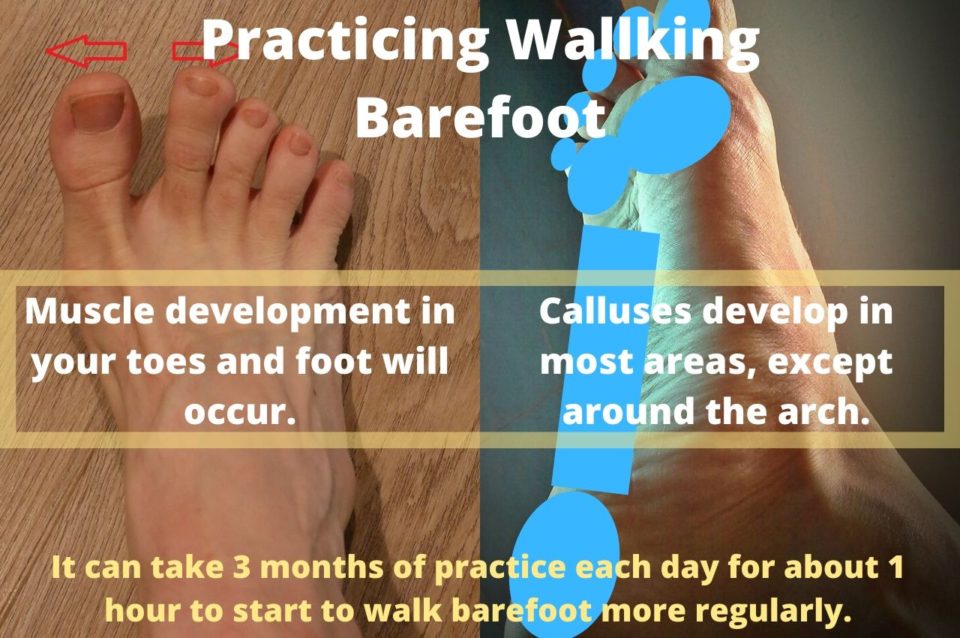
Walking barefoot may be a goal of yours because you’ve heard about the benefits to your foot health. Just like any type of exercise program, the more you work out consistently the faster you develop a healthier stronger body.
The skin on the bottom of your foot can develop a thicker skin as it comes into contact with the ground and friction occurs over time. If you’ve ever played the guitar, you’ve noticed that it takes about a week of playing for 30 minutes to an hour for your fingers to start to develop calluses.
After about 3 weeks your fingers that you have used develop calluses as you playing the guitar. Expect that time to be at least twice as long or more when walking barefoot. It all depends on the circumstances. After about a month, your feet should develop calluses and rough surfaces won’t be as sensitive. You’ll also be able to walk on hotter surfaces a bit better.
The other part of walking barefoot is the need for muscle development. Although you don’t need strong foot muscles to start to walk barefoot, if you plan on doing it often you’ll want your muscles to develop well so you can have good control of your toes.
You’ll also want your arch to get stronger since your foot no longer has a shoe to cushion it when it lands on the ground. If you practice for up to 10 minutes a day walking barefoot in fairly safe environments for a month, your toes and arches can slowly gain strength.
The next month (month 2) you can expand the time you walk barefoot to ensure your feet have developed calluses on the pads of the feet where pressure is applied to the ground. Once you have calluses and feel your feet are strong enough, you can start to take walks on the sidewalk for 15 minutes up to 30 minutes.
Walking for longer distances and using your foot muscles, while barefoot, for more physical activities should be done with care. Recognize your limits and if you are stubbing your toes too much or it hurts to walk on small twigs and pebbles.
If your feet hurt are hurting, your muscles and calluses are likely not ready for any long walks anywhere.
On month 3 you should have both the calluses and better muscle development to start walking barefoot for about 30 minutes to an hour. Gauge your abilities by checking how much comfort you have while walking on somewhat bumpy or prickly ground and how well your can control your toes. (Any stubbed toes lately?)
On month 4, all depending on how much you have walked barefoot each day, you should be able to walk barefoot in many conditions. Of course, if the ground is sharp or somehow unsafe, you need to wear shoes to protect your feet.
During the first few months of walking barefoot, consider doing a weekly checkup on your feet to see how calluses are developing and how your foot is feeling overall.
Steps to Take to Walk Barefoot
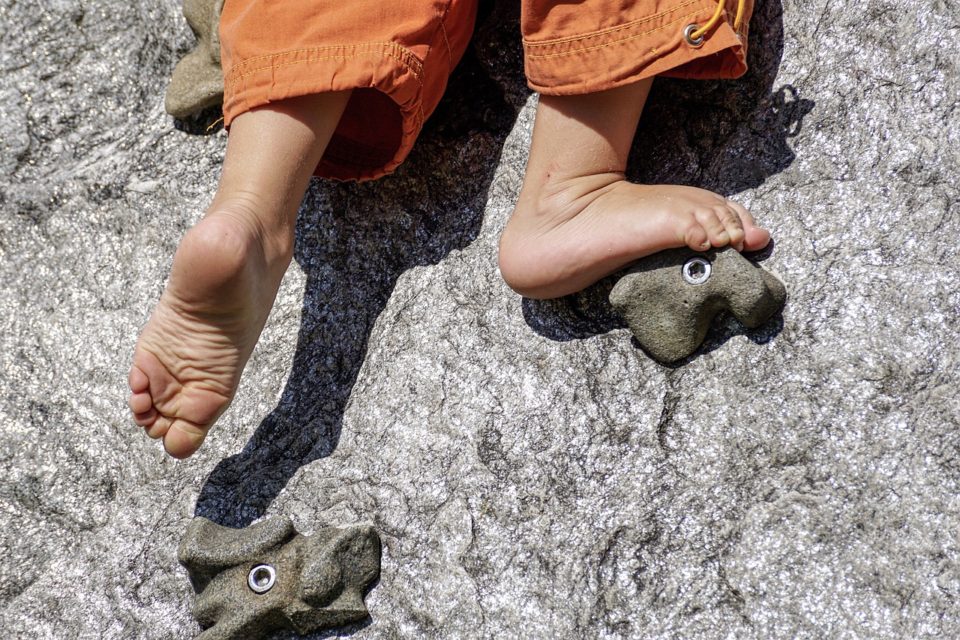
1. Check Your Arch
When you have been wearing shoes all your life and want to start going barefoot, you should be aware that some people will not take to it very well. The foot needs to have arch support, and if you suddenly take away the arch support from your shoes, your foot and could start to have problems.
Most people whose feet are fairly healthy, are not overweight, and have some muscle development in their foot, will be fine with walking barefoot for short periods until they have adapted to it.
For those who have feet that are not strong, have extra weight, have used arch supports, or do not walk, run, or exercise much, they will need to start developing their muscles while wearing their shoes first.
An arch needs to have some support from muscles and correct bone alignment. If your arch is fine and your feet are healthy, you should be fine starting to practice walking barefoot. If your arch does not have the support it needs, it can collapse over time.
Walking barefoot can help your muscles develop and help support your arch, but you need to make sure your feet are ready to take that consistent weight over time. Your doctor can help you decide what to do if you’re unsure.
2. Take Your Time
When starting out, it’s important to remember to take it slow. After a few days, you’ll start to recognize how long you can walk barefoot without hurting your feet.
I would recommend trying to walk barefoot in your house to start. You’ll likely be able to walk barefoot for long periods in your house. If you are finding that your muscles are out of shape and you are stubbing your toes often, walking inside your house is good practice until your muscles get used to walking without shoes.
You can then start going outside for 10 minutes for a couple of days in a row and walk on the sidewalk, grass, and softer dirt areas. This will start to apply new pressure and friction to the soles of your feet. After 3-5 days you can measure better how much time you can spend on your feet outside.
If your feet feel fine, try walking for up to 30 minutes for a couple of days, and give your feet a rest for a few days whenever they need time to recover or if they are getting blisters. Then you can decide if you need to adjust the time that you are walking outside.
3. Check Your FeetEach Day
As you walk barefoot daily, you’ll want to maintain healthy feet during this process. Now that your feet are exposed to the ground, you can encounter more than just scrapes and stubbed toes. You may be walking in areas that have bacteria and fungus.
Maintaining healthy feet will be more important than ever. Makes sure that you are well hydrated to help your skin stay moisturized, and applying moisturizer or balm to your feet will ensure that as you get scrapes and more intense pressure, your skin stays pliable and doesn’t crack.
If you do have cuts or cracks, address this issue right away to prevent any infection. It’s OK to take a couple of days off from walking barefoot to ensure your feet are healed before going barefoot again.
If you are having any pain in your foot as you walk, consider seeing a doctor before walking barefoot again. Some people will need to slow down the transition to walking barefoot because their feet need more muscle development (article) to start.
4. Clean Your Feet and Moisturize
Good cleaning practices will ensure that you avoid problems that could occur from exposure to foot infections. You’ll be building muscles in your foot and leg, so your foot can function with more and more dexterity over time, but as you are beginning this process infections could occur if you get a cut or scratch and don’t take care of cleaning your feet well each day.
Moisturizing will help your feet get fewer scratches. Your skin will be more pliable so you can walk over scratchy surfaces without worrying about your skin cracking. There are many products available for your feet to keep them moisturizing and remember that drinking plenty of water each day will also keep your skin softer and hydrated.
5. Try a Different Type of Shoe
When your feet are used to arch support provided by your shoes, they will take time to adjust to the new environment of no arch support when walking barefoot.
One way to help you transition to less arch support is to get shoes that help with muscle development. These shoes usually have a wide toe box and less cushion. This allows your toes to work more and for your feet to start developing a bit more muscle.
The thinner cushion means that more work needs to be done by your muscles, arch, and toes to walk and run. Like walking barefoot, you want to transition into wear these types of shoes slowly. Wear them once a week and then more often if your foot is adapting to it well.
After several months, your feet will have developed a bit more and this will aid your transition to walk barefoot.
6. Set a schedule
Practice, practice, practice. The more you practice each day, the stronger your feet will get. Just take it slow, but be consistent.
If you schedule your barefoot time, you will more likely achieve your goal of walking barefoot with more ease. Try walking barefoot for a set period each day and adjust the time when needed. A weekly schedule will help you determine your progress toward walking barefoot for longer periods.
A monthly schedule of walking barefoot might look something like this chart. Each person is different and they will need to adjust how much time they walk barefoot each day.
Time to Walk:
1st Week –
5 Minutes
Start by walking barefoot for 5 minutes each day for 3+ days to see how your feet feel. You’ll be able to tell how long you need to
1st Month –
10 Minutes
If your feet are doing well, try about 10 minutes of walking barefoot 3+ days a week for about a month. Give yourself days off to recover when needed.
2nd Month –
30 Hour
Try walking for up to 30 minutes on the second month of walking barefoot, if your feet are ready. Transition by adding more time little by little.
3rd Month –
1 Hour
After two months of walking barefoot, you can possibly walk for longer periods. Your feet should have more strength and enough calluses to walk for up to an hour.
What are the Benefits and Disadvantages of Walking Barefoot
Many people will find it uncomfortable if you are walking without shoes in public in America. Some countries find it very normal. In America, you may need to have shoes to enter a store because they “require it”, especially if it is a restaurant.
But, there is no health code against going barefoot in public or in stores, so it should be legal in most places. You may not want to go into a public store or restaurant barefoot until you have gone barefoot for a while to ensure your feet are ready, but you can if you want.
Some people will judge, while others will feel uncomfortable, especially if you are barefoot in a restaurant. A middle-ground for those who want to go barefoot and not attract too much attention is to wear minimalist shoes.
These shoes are similar to walking barefoot, but provide a covering for your feet. When people see the dirty soles of someone’s feet, they automatically equate it with homelessness, poverty, uncleanliness, and uncertainty. You may have to be more social and friendly if you want to help break the ice when people stare at you.
You’ll also see some of the benefits of walking barefoot when your legs and feet are stronger. It can help with walking more balanced and improve your overall body mechanics. This can help some people who experience joint pain.
The list below shows some of the pros and cons of walking barefoot.
Pros
- Can help with arch support
- Better foot and leg mechanics
- Can help with joints and alignment
- Increased muscle strength
- Increased tactile perception
- Improved balance
- May decrease stress levels
Cons
- Injuries to foot – foot less protected
- Infections could occur
- People may judge you or feel uncomfortable around you
- Injury may occur with weak foot muscles.
- Your feet can get too hot or too cold
- Your feet get dirty
How Long Do I Walk Barefoot Before Running Barefoot?
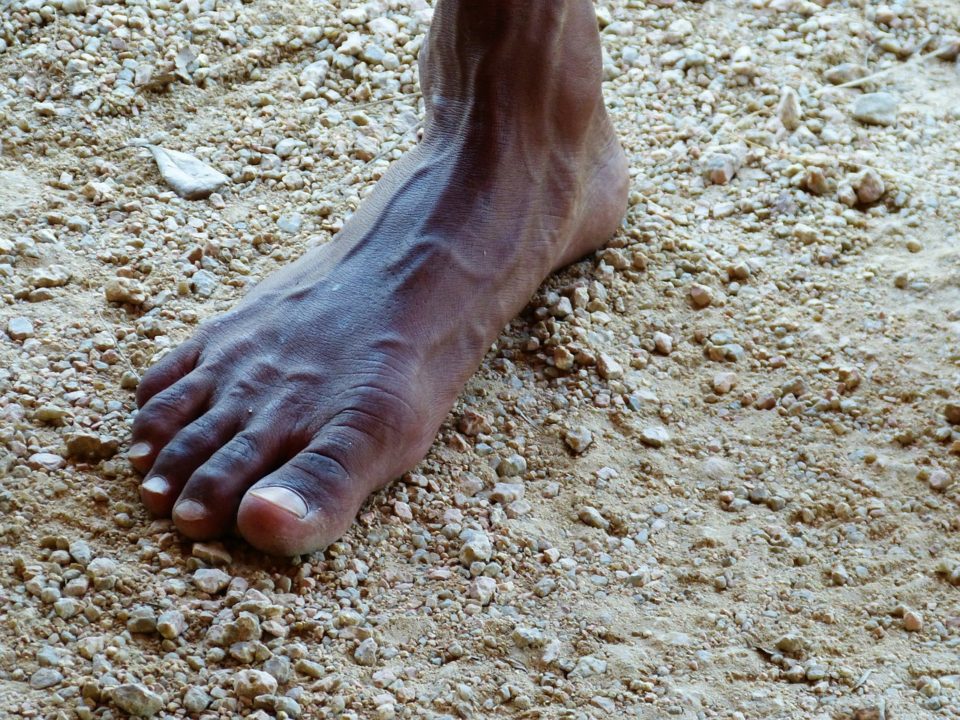
Walking barefoot can help you transition to running barefoot. If you are not used to running though, you should generally begin running with shoes first. Learning to run barefoot may be fine for short periods, but long-distance running places more demand on the body than undeveloped feet can handle.
Those who have been wearing shoes, most of their life will likely need to wear shoes to start running. This will help them learn how to run properly with less likelihood of causing injury. Your foot needs to develop muscles and having some support from a shoe is important for beginning runners.
Walking and running are different in many ways. Although you may have been practicing walking barefoot for a couple of months, that doesn’t mean your feet are ready to run barefoot.
You could go running for a couple of minutes barefoot to see what it is like, but your muscles are not accustomed to running yet and if you plan on running regularly, it’s best to use shoes first to decrease the likelihood of injury.
Later, after maybe six months of walking barefoot and running with shoes, your feet might be ready for the transition to running barefoot. Although you would significantly reduce how long you run barefoot than you would normally run with a shoe, and then slowly increase your barefoot running.
What Can I do Today to Practice Walking Barefoot?
Hopefully, you have some recreational areas to go to and enjoy the outdoors. Some of the places you may want to try are the park, the beach, and the lake. Be aware of any hazards in these areas, so you can keep your feet safe.
Be prepared with bandages and cleaning supplies. You may also want to carry some soap, water, and a cloth to clean your foot in case you step in something messy. Having fun and being barefoot can give you an idea of how nice it is to be barefoot.
With some consistent time walking around barefoot each week in one of these places you may start to feel the changes and see some of the benefits of walking barefoot.
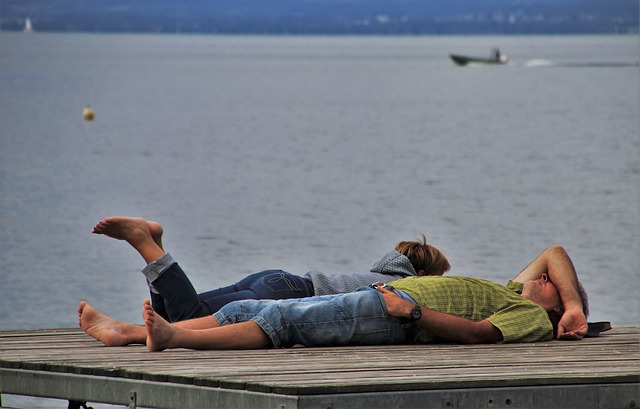
Get Down to the Lake
Walk around the dock and beach barefoot. Be aware of any hazards, but see how well you can walk on the sand, dirt, grass, and wooden planks.
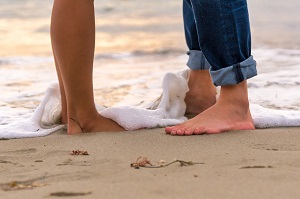
Go to the Beach
The beach is great for walking long distances. You safely walk barefoot and see how your muscles are used if you walk for a while.

Go to the Park
Most parks have large grass areas to walk in. There may be some hazards, but it’s a good place to play a game. (soccer, football, baseball)
Conclusion
I think of being a kid when I consider going barefoot. It is a natural way to enhance your life and with some practice, anyone can start to benefit from walking barefoot. If you take a bit of time each day to walk barefoot, in a few short months you can start walking barefoot in many places you’d like to go.
Taking care of your feet will help you when walking barefoot. And as you walk barefoot over time, your feet will start to help you with overall body mechanics, which can relieve issues that some people have with their joints. Why not try going somewhere this weekend to try walking barefoot outside and see how it feels.
Thanks for visiting Helpshoe.com

